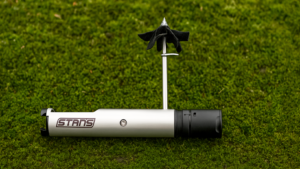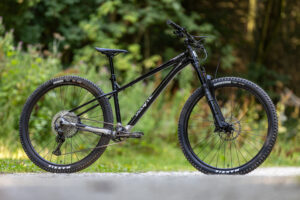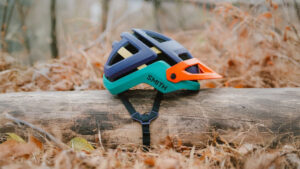The Giant Trance X Advanced 1 gets silky smooth and open suspension, multiple gometry settings and a killer spec.
I tested the original Giant Trance 20 years ago: the latest Trance X has the same peppy feel and it’s one of the smoothest and fastest trail bikes around
For almost as long as I’ve been testing bikes – quite a while, as my aching bones regularly remind me – the Trance has been Giant’s go-to trail bike. It debuted in 2005, and I have a feeling I must have first reviewed one close to twenty years ago too.
– Short of time? Click here to skip to the verdict –
During all that time and through multiple iterations of the Trance that have seen wheel sizes change, travel shrink and grow, and geometry steadily lengthen, the basic remit has remained: Trance is Giant’s efficient, do-it-all, trail bike and has always been the most versatile full suspension bike in its range for me.

Giant’s Trance X Advanced 1 has a smidge less travel than many trail bikes, at 150mm front/140mm rear, and uses a full 29in wheel set-up.
This latest X version has 140mm rear and 150mm front travel, and it’s available in carbon (Advanced) or aluminium with various adjustment options and an on-trend downtube luggage box.
While it’s shiny, sleek and fresh looking, you can spot the model’s heritage in the basic shape and rear Maestro suspension, which uses a twin link design wrapping both ends together over the bottom bracket and at an upper rocker. The back end is marginally longer than some trail bikes, at 439mm, and overall the X version geometry isn’t particularly slack or aggressive. But Giant also offers an SX version that uses a 27.5in rear wheel, it gets a slightly longer shock stroke to achieve 5mm more travel and a significantly more relaxed head angle.

Maestro suspension is at the heart of the Trance X, it’s claimed to isolate pedalling forces frame movement
The chameleon-in-the-light carbon finish on this Advanced 1 version looks amazing, with a funky, semi-transparent, purple/green lacquer that exposes the raw weave. There’s some pretty swanky kit that does the finish justice too; Fox Performance Elite at both ends with the superior GRIP2 damper in the 36 fork up front, and a mixture of a SRAM GX Eagle AXS drivetrain and Shimano XT brakes.
Solid own-brand finishing kit includes wide, rounded rimmed TRX hookless carbon wheels clad in Maxxis rubber. Not bad, when Giant’s whole package costs under six grand. This 1 model is also pretty light too, at just under 14kg (and feels even lighter when you pedal it), which is very respectable for a modern, capable trail/all mountain bike.
Design and specifications
The latest Trance X frame ups travel over the previous model by 5mm to 140mm. There’s a neat Trunnion mount shock, which Giant bumps to a slightly longer 55mm stroke and 145mm on the SX version.

Internal frame storage features on the new Trance X, but the door is too dinky for my liking
The whole frame is carbon except the lower welded aluminium rocker link too and there’s a new downtube stash that’s actually big enough to actually stash things in.
The Trance is also really adjustable compared to many trail bikes. Three different flip chip positions at the top of the seat stay use either an oval chip with a central hole or a spare included chip with an offset hole that can be orientated either way.

140mm travel is the sweet spot for modern trail bikes
To change the geo takes literally about a minute and can easily be done trailside with a multi tool. Giant recommends using mid or low positions with a 29in rear wheel and the mid or high position on the 27.5in rear SX. Incidentally, the SX can’t be set up full 29in, as with the extra rear travel there isn’t enough room to clear the seat tube at bottom out.
As well as altering the bottom bracket height, the flip chips also bring a slacker head angle in the lowest setting and a slightly steeper one in the higher setting. There’s also 10mm of frame reach adjustment to move the fork steerer in the headtube, achieved via swappable headset cups that (again) are a cinch to change over and experiment with.

Giant lets you tweak the bike’s reach via inset headset cups
Although the Large bike here comes with an on-the-money 480mm reach, I ended up putting it in the longest (485mm) position as it felt a tad shorter than advertised for some reason… likely because the wheelbase isn’t the longest with the bike’s 64.5° head angle.
With double 29in wheels, the Trance X is slightly steeper than many modern trail bikes in the mid setting, although the head angle goes to just under 64.5° in the low flip chip position.
The seat angle is listed at 77.2°, which is marginally slacker than some bolt-upright enduro bike climbing positions, but don’t let it fool you; I found the saddle perfectly placed for both climbing and pedalling and didn’t have to fiddle the seat forward on the rails – a standard tweak on many other test bikes.

Shark toothed chainstay protection and good internal cable routing kept the bike quiet most of the time
The four sizes go from 430mm to 510mm reach (there are no chainstay changes with size though), with all frames using Giant’s advanced composite technology and a Fox Float X shock. The latest frame has also beefed up its impact protection with a long downtube rubber bumper and a ribbed chainslap guard on the top of the chainstay. Cable routing is internal throughout, except for the last part of the rear brake routing.
I’ve included the suspension graphs here for how the Maestro link is configured on the Trance X. The bike is slightly unusual compared to many modern trail bikes with lower anti-squat and anti-rise numbers and a (more typical) moderately progressive leverage curve that moves from around 3:1 to 2.4:1. I’ll try and decipher what this might mean in terms of ride feel later in this review.

A 50mm stem has no place on a modern trail bike, I slashed it down to 35mm to stop the steering feeling vague
Components
Aside from the proven Fox, SRAM and Shimano blend, Giant uses a chunk of own-branded kit. The 780mm SLR handlebar is a low-ish 20mm rise/35mm diameter alloy bar with a decent shape, but this Large bike came with a 50mm stem, which made the steering feel too vague and floppy. I swapped it for a 35mm and put the frame in the longer headset position.
The seat angle feels steeper than advertised when you actually ride and I had no issues with Giant’s Contact dropper that you can adjust from 170-200mm travel, or the comfy Romero SL saddle.

The 30t chainring isn’t there to save my ageing legs, instead it gives a better chainline for pedalling
SRAM’s 170mm-cranked GX Eagle AXS drivetrain uses a 30t front chainring, which I actually enjoyed the easier gearing on. Maybe I’m getting old. But it’s more likely chosen the 30t to lower the chain line and better suit the Trance’s reduced anti-squat figures, helping the pedalling feel smoother and tighter.
It works well and sees the bike accelerate really fast, which might also be down to the lightweight Giant TRX carbon wheels and faster-rolling MaxxTerra tyres, which have a less spiky tread than some more enduro-y tyres.
The 40mm wide wheels look slightly funky (and almost as wide as Plus wheels from a few years back), but claim a standard 30mm internal width. The tyres look very spread out at the sidewalls and pretty squared off on top to me though, and this contributed to an issue with grip from the front Minion DHF.

The Minion DHF is old hat now, I swapped it out for an Assegai and found I could push much harder
Why? It was occasionally scary how much the tyre could step out or surf on dirt when loaded and leant on hard. I know Minion DHFs used to be a classic, but tyre technology has moved on and it’s actually pretty bad now compared to the latest Conti’s and Schwalbes or Maxxis’s own Assegai.
Basically, I couldn’t ride the Trance to its full DH potential without crashing until I changed the front to an Assegai, and I’d recommend anyone else do a swap too and accept a minimal hit on rolling speed.

40mm rims pushed the tyres’ shoulders out for a squarer profile, which actually suits the Dissector on the rear
The wheels themselves feel great though; really light to spin up fast and dynamic enough that the bike feels really agile and light. They are also very comfortable and smooth across the ground compared to many jagged, stiff and sharper carbon wheels (and Giant’s older carbon wheels I’ve ridden before).
Slowing the Trance down, I had the same problem with XT brakes I’ve had far too many times. Perhaps the cheaper one-piece Shimano rotors didn’t help, but the intermittent bite point at the lever made braking very unpredictable. The brand new Shimano XTR M9200 groupset with Di2 seems to have solved this problem, but it won’t help the Trance X here. the pads also seem to glaze over and take a while to bed in again if you leave the bike standing for a while after a muddy ride.

I spent hours on the Trance X, racing, riding and getting to know the bike
Performance
I ended up putting a lot of time into the Trance X. Not because it was difficult to sort out or had me endlessly faffing to find a sweet spot, just because I really enjoyed riding it. Giant’s rig basically felt ideal razzing around UK trails during the unusually sunny and dry weather we’ve had.
Imagine what a sorted 140mm do-it-all bike should ride like and the Trance hits the bullseye. It’s not too skewed towards either ruthless XC efficiency or too much stability and a DH attitude, but isn’t so middle of the road it’s boring either. With slightly steeper angles, it’s very manoeuvrable and can really be chucked about and picked up and placed on the trails.
It’s easy to manual, even with 439mm chainstays that place rider weight slightly further forward than some, and it’s a cinch to let the back tyre scuff out on purpose, Scandi flick into corners or pick it up and over little crests and steep hairpins.

The Yeti SB140 has nearly the same kind of pop as Giant’s Trance, but it’s more DH focussed
Aside from the reactive handling, another standout characteristic is how smooth the Trance rolls. Little roots and stones barely chip any speed away as the tyres skip over, much like the Yeti SB140 Turq Silverfish Edition I reviewed.
There’s loads of comfort thanks to a soft, slinky and compliant carbon frame that yields a bit and really massages the ground. With a 150mm 36 fork that uses the sorted 4-way adjustable GRIP2 damper, it’s not in any way a rough or jarring ride and, if anything, feels even smoother and more isolated from chatter than the 140mm Yeti, with almost the same geometry and travel.
Giant’s Fox Float X rear shock is perfectly tuned, with enough damping and support to balance against all the freedom of movement and suppleness off the top in the back end too, so tyres track beautifully and give you loads of off camber grip.
Climbing
This carbon Trance is super smooth then, but also a brilliant climber and pedaller with uphill prowess to rival many downcountry or shorter travel bikes like the Santa Cruz Tallboy CC X01 RSV I ride a lot. There’s stacks of grip and it really surges forwards under power, and, even stood up stomping, the pedal action is even. There’s just a little bit of bob in the top two gears of the cassette on really steep pitches.
I normally really like the cornering feel of ultra-low BB bikes, but here I didn’t get on with it at all, after adjusting the flip chip to the lowest setting. It seemed to upset Giant’s steering and also the suspension kinematic. The Trance didn’t pedal as well on the climbs and felt more wallowey with feet lower down, which didn’t seem to suit the personality of the bike. I quickly reverted straight back to the mid setting.
My gut sense is the superb climbing ability here is something to do with the reduced anti-squat, giving loads of extra grip on lumpy and loose surfaces. It’s a bit like the rear tyre caresses the ground, rather than pushes into it too hard on the downstroke, and this sensation meant I didn’t ever lock the back end out off-road to winch up the trickiest sections. Overall, I really enjoyed climbing and ticking off technical uphill challenges here, rather than just putting up with it like on most bikes.

Flowy trails like this let the Trance X shine, pumping through the corners like a hardtail
Descending
In 90% of riding scenarios, there’s plenty of capability in the rider position, geometry and supple suspension. But if you absolutely bomb down the fastest roughest and steepest tracks, you can reach the limit of stability and control quicker than some equivalents. This became even more apparent when I raced the Trance X in a local enduro race called the Boltby Bash.
The bike suited the terrain perfectly, which was hand-cut tracks down loamy woods of the kind you get all over the UK, with stages that aren’t particularly steep (think Surrey Hills or Forest of Dean). The race segments had nice dirt, smaller root webs and a few smaller rocks, rather than anything too lumpy, rough or continuously rocky like Scotland or Wales. So while the clock was ticking, I needed to pedal really hard to do well. The Giant sprints really (really) urgently and effectively during all the out-of-corner and off-the-start-line efforts needed, plus there’s mostly enough stability to charge on the more downhill bits.

Maestro and the Float X proved a great team, with a light tune on the shock and less anti-squat than on similar travel bikes
Where the Boltby trails were steeper for longer, and rougher from previous riders, I really felt it on this Giant though. Some 140mm rear travel bikes like the Yeti SB140 or Specialized Stumpjumper 15 Pro Carbon jiggle you around a bit but still remain stable and planted. They let me focus on where I’m going without shaking my head so hard I lose vision.
I found things got quite frantic once or twice taking risks while racing the Giant and it can feel more worked over and out of its depth. It’s especially noticeable how it’s less composed and calm slamming on the brakes to kill speed in really blown out channels and compressions, and I’m guessing it’s related to how smooth and slinky the chassis feels elsewhere. The Trance is softer rather than rock solid and even feels more twisty and flexier compared to my 120mm travel Santa Cruz Tallboy.

Giant’s Advanced carbon comes alive on a bike like the Trance X, it’s never wooden or too solid in feel but didn’t feel overly flexy either
So, the Trance X can feel a little bit too lively/twangy and not stiff enough to handle heavy loads and twisting forces if you really smash it into pocket berms or land heavy off jumps. This is only a slight sensation though, I’m quite a heavy rider, and, to be fair, the bike isn’t advertising itself as an enduro bike in the first place.
Stick to trail bike terrain and it’s fast, efficient, smooth and absolutely in its element. Something like the Yeti SB140 might offer a bit more versatility with its extra DH capability, but that bike is also many thousands of pounds more cash than this Giant that I reckon is offering great value for how sweetly it rides.

Giant Trance X Advanced 1
Verdict
Giant’s gorgeously-finished 29in wheeled Trance X is one of the smoothest and fastest trail bikes around. It’s fun, engaging and reads dirt like brail to inform you exactly what’s going on at the tyres, without being unnervingly sharp and edgy. Giant’s Advanced carbon chassis and wheels feel as well damped and smooth as the suspension, and the Trance rides even lighter than the scales suggest and pedals and climbs superbly. While it’s likely perfect for the vast majority of UK trails and can really motor, this is a turn-on-a dime pure trail bike, rather than any kind of slacked out enduro wannabee or mini DH bike. It operates best in a window anywhere from easy flowing trails up to easier enduro trails, so long as there isn’t too much steepness or chunk.
















